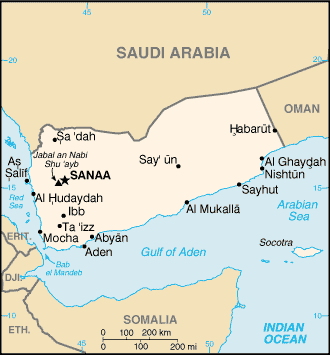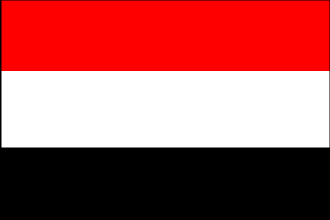
|
Yemen
Background:
North Yemen became independent of the Ottoman Empire in 1918. The British, who
had set up a protectorate area around the southern port of Aden in the 19th
century, withdrew in 1967 from what became South Yemen. Three years later, the
southern government adopted a Marxist orientation. The massive exodus of
hundreds of thousands of Yemenis from the south to the north contributed to two
decades of hostility between the states. The two countries were formally
unified as the Republic of Yemen in 1990. A southern secessionist movement in
1994 was quickly subdued. In 2000, Saudi Arabia and Yemen agreed to a
delimitation of their border.
Location:
Middle East, bordering the Arabian Sea, Gulf of Aden, and Red Sea, between
Oman and Saudi Arabia.
Area: Total: 527,970 sq km.
Area - comparative: Slightly larger than twice the size of Wyoming.
Land boundaries: Total: 1,746 km, border countries: Oman 288 km, Saudi Arabia
1,458 km.
Coastline: 1,906 km.
Climate and Terrain:
Mostly desert; hot and humid along west coast; temperate in western
mountains affected by seasonal monsoon; extraordinarily hot, dry, harsh desert
in east
Narrow coastal plain backed by flat-topped hills and rugged mountains;
dissected upland desert plains in center slope into the desert interior of the
Arabian Peninsula
gold, lead, nickel, and copper, fertile soil in west
Land use: arable land: 3%, permanent crops: 13%, permanent pastures: 33.5%,
forests and woodland: 4%, other: 46.5%.
People:
Population: 18,078,035.
Ethnic groups: Predominantly Arab; but also Afro-Arab, South Asians, Europeans.
Religions: Muslim including Shaf'i (Sunni) and Zaydi (Shi'a), small numbers of
Jewish, Christian, and Hindu.
Languages: Arabic.
Government:
Government type: Republic.
Capital: Sanaa.
Economy overview:
Yemen, one of the poorest countries in the Arab world.
Agriculture: 20%, industry: 42%, services: 38%.
Unemployment rate: 30%.
Industries: Crude oil production and petroleum refining; small-scale production
of cotton textiles and leather goods; food processing; handicrafts; small
aluminum products factory; cement.
Agriculture - products: Grain, fruits, vegetables, pulses, qat (mildly narcotic
shrub), coffee, cotton; dairy products, livestock (sheep, goats, cattle,
camels), poultry; fish.
Statistics:
Telephones - main lines in use: 291,359.
Telephones - mobile cellular: 32,042.
Radio broadcast stations: AM 6, FM 1, shortwave 2.
Radios: 1.05 million.
Television broadcast stations: 7.
Televisions: 470,000.
Internet users: 12,000.
Highways: Total: 69,263 km paved: 9,963 km unpaved: 59,300 km (1999)
Airports - with paved runways: Total: 13, with unpaved runways: Total: 37.
Return to Visiting Locations
|

